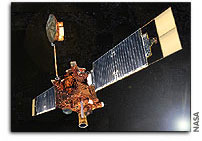NASA Loses Contact With Mars Global Surveyor

Engineers are striving to restore full communications with NASA’s Mars Global Surveyor on the 10th anniversary of the spacecraft’s Nov. 7, 1996, launch.
The orbiter is the oldest of five NASA spacecraft currently active at the red planet. Its original mission was to examine Mars for a full Martian year, roughly two Earth years. Once that period elapsed, considering the string of discoveries, NASA extended the mission repeatedly, most recently on Oct. 1 of this year.
The orbiter has operated longer than any other spacecraft ever sent to Mars. It has returned more information about Mars than all earlier missions combined and has succeeded far enough beyond its original mission to see two later NASA orbiters arrive: Mars Odyssey and Mars Reconnaissance Orbiter. Among many important accomplishments so far, Mars Global Surveyor has found many young gullies apparently cut by flowing water, discovered water-related mineral deposits that became a destination for NASA’s Opportunity rover, mapped the planet topographically and examined many potential landing sites on Mars.
On Nov. 2, one orbit after commands were sent for a routine maneuver to move the solar panels, the spacecraft reported that the motor moving one of the arrays had experienced errors. Onboard software responded as programmed, switching the spacecraft to a backup motor controller, then to a backup circuitry connection.
Following these indications of difficulty, a two-day lapse in contact occurred on Nov. 3 and 4. The signal from the spacecraft was received on Nov. 5 during four different orbits, but it did not carry any data from the spacecraft. The signal’s frequency indicated that the spacecraft had entered safe mode, a pre-programmed state of restricted activity in which it awaits instructions from Earth.
No further signal was heard during subsequent orbits on Nov. 5 and Nov. 6. Engineers concluded that the spacecraft had made an additional pre-programmed response, intended to help it survive when it senses that a solar array is stuck. The spacecraft turns that array toward the sun to maintain its power supply and rotates the rest of the spacecraft in the same direction, thereby making communication with Earth less effective.
“The spacecraft has many redundant systems that should help us get it back into a stable operation, but first we need to re-establish communications,” said Tom Thorpe, project manager for Mars Global Surveyor at NASA’s Jet Propulsion Laboratory, Pasadena, Calif.
Further information on the recovery of the spacecraft will be released as it comes available.









